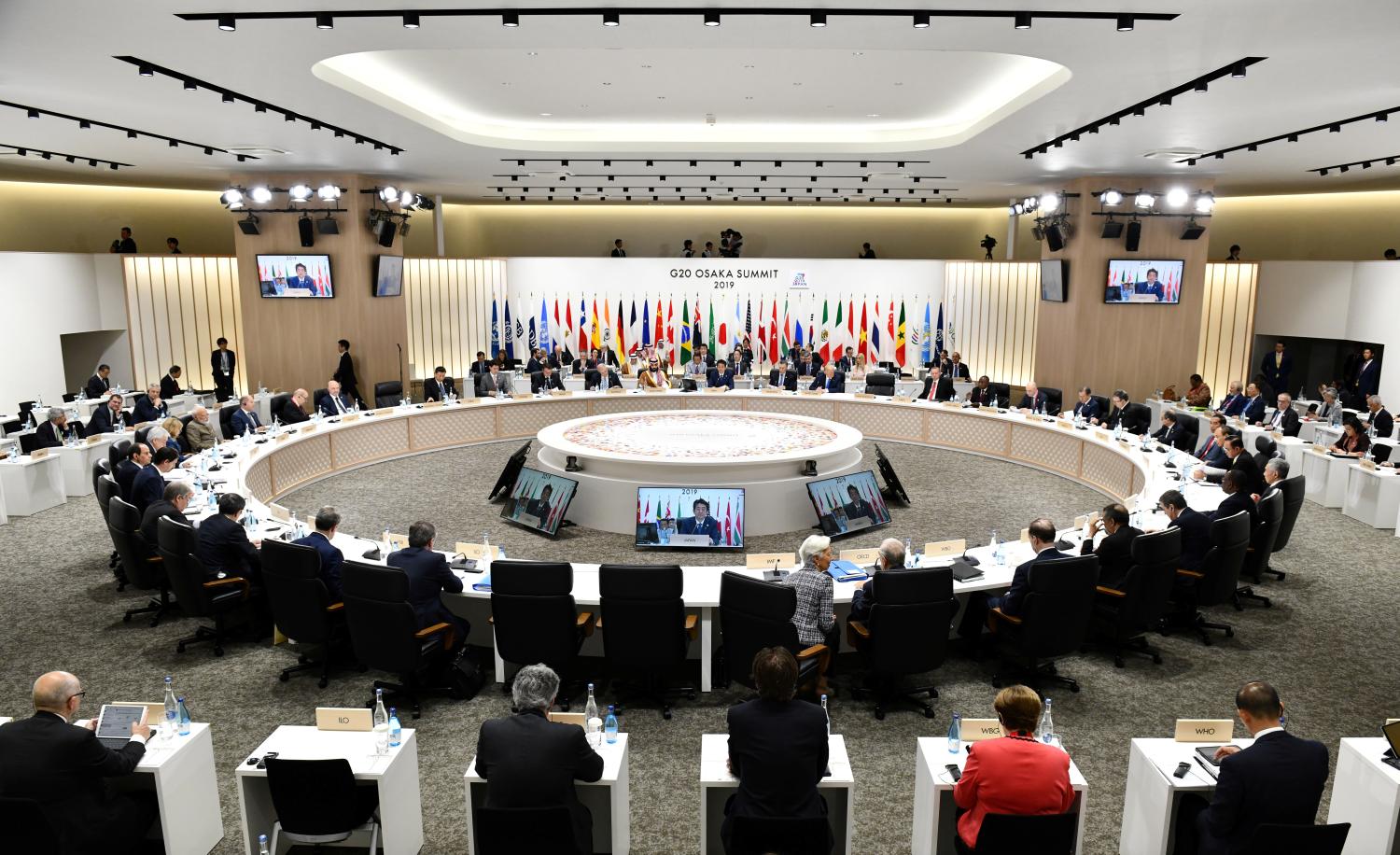Updated to reflect the addition of Thomas Wright’s paper to this theme in July 2020.
 In the wake of China’s increased assertiveness abroad and Russia’s interventions in Ukraine, Syria, and U.S. elections, great power competition has captured the attention of Washington’s policymakers and analysts. For many in the strategic community, great power politics is primarily understood as a shorthand for the bilateral competition between the United States and China (or between the United States and Russia). But great power politics is in fact about much more, and the ties between both China or the United States and the other great powers are of critical importance — with the power to shape U.S.-China competition and the international system.
In the wake of China’s increased assertiveness abroad and Russia’s interventions in Ukraine, Syria, and U.S. elections, great power competition has captured the attention of Washington’s policymakers and analysts. For many in the strategic community, great power politics is primarily understood as a shorthand for the bilateral competition between the United States and China (or between the United States and Russia). But great power politics is in fact about much more, and the ties between both China or the United States and the other great powers are of critical importance — with the power to shape U.S.-China competition and the international system.
To explore these relationships, the papers in this installment of the Brookings Foreign Policy project “Global China: Assessing China’s Growing Role in the World” explore China’s ties with the great powers — notably the United States, Europe, Japan, India, and Russia — as well as the implications of those relationships for the United States and international order.
The papers reveal that a key development in great power politics is the strong position of Washington and Beijing relative to the other great powers. Indeed, with both countries’ economic and military strength and leadership in technologies like artificial intelligence, the United States and China are outpacing the other great powers — and that gap is growing. In light of this widening separation, it is increasingly clear that decisions made in Beijing and Washington will play a major role on questions regarding geopolitical stability, global and national economic growth, emerging technology, and international values and institutions. At the same time, the fast-deteriorating relationship between these two countries will also form the broad structure within which the other great powers maneuver.
The intensifying U.S.-China competition is an important factor affecting the policies of the other great powers. For China, stabilizing ties with other great powers provides a hedge against the downturn in relations with the United States. And given the Trump administration’s unpredictability, trade protectionism, and limited reliability as a security partner, great powers like Japan and India have seized on China’s receptiveness as an opportunity for improved ties — albeit with limits. Tokyo, for example, has managed to achieve a thaw in the political and diplomatic relationship even as security and economic competition intensifies, indicating the sophistication of both governments in managing bilateral ties. For Delhi, the reduction in tensions with China has been less pronounced; China and India have been pursuing limited cooperation and sustained engagement while also seeking to compartmentalize areas of discord. These improvements are of course limited: for both India and Japan, concerns about status, China’s growing regional role, and especially ongoing territorial disputes continue to constrain room for better relations and form part of the reason for their continued pursuit of strong bonds with the United States broadly and President Donald Trump personally.
China’s other neighboring great power, Russia, has also seen its ties with China improve. The growing and unmistakable convergence between Moscow and Beijing is among the most important trends reshaping the web of great power ties. China and Russia share a mutual interest in challenging a world order dominated by the United States. Russia provides China with military hardware, energy, and Arctic access; China is Russia’s largest trading partner and provides capital, technical expertise, and a market for Russia to further develop its natural resources; both provide each other support in diplomatic bodies. The depth and duration of this trend of strengthening Sino-Russian ties will be a key feature to watch going forward.
The papers in this series examine these dynamics and their implications for the international system in greater detail. They also offer policy options for the United States and other countries.
As Bruce Jones notes in a sweeping analysis of the ways great power politics intersects with international order, China’s rise marks the first time since the creation of a global system that an illiberal power has the reach, capacity, and ambition to re-shape the rules of the international order. Jones highlights several key features of the current system: the continued weight and scale of the United States; the new position and global policies of China; a layer of powers (the European Union, the United Kingdom, Russia, India, and Japan) vying for space and security; the wide and deep network of multilateral institutions; and the presence of an informed and active network of civil society, private sector, and general public. Among the most critical factors, he notes, is the growing power gap between China and the United States — the top two powers — and the rest. This fact will force the other powers to pay close attention to the preferences of both Washington and Beijing, as well as the tensions between them.
Jones also argues that the United States will be better able to shape the international order if it recommits to (but also retools) the alliance system and returns to a wider appreciation of the multilateral order. Washington will need to navigate the reality that China can claim a full seat at the table in certain domains. That forces an uncomfortable choice between acceding to a sharing of power or driving a degree of economic decoupling — potentially leading to the emergence of two zones of globalization. If the U.S. and China continue to pursue strategic rivalry, and if their relationship continues to deteriorate, Jones suggests that a kind of bifurcated globalization will develop — two zones of technological, infrastructure, and commercial integration.
Ryan Hass explores the key force driving that possibility: the U.S.-China relationship. He argues that the relationship is deteriorating faster than at any point since 1979, when the two countries first established diplomatic relations. While several factors have contributed to the downturn in relations, Hass identifies four in particular:
- Washington and Beijing’s dissatisfaction with the status quo;
- China’s emergence as a global rule-maker;
- the growing centrality of technology competition in the bilateral relationship; and
- the intensification of ideological and systems competition.
Hass offers several recommendations to U.S. policymakers for restoring equilibrium to the U.S.-China relationship, including right-sizing the risk that China poses to U.S. interests; developing a shared framework between Washington and Beijing for understanding the nature and distribution of power in the U.S.-China relationship; re-learning how to shape China’s behavior; and focusing on national cohesion and American renewal. He concludes that the United States and China can coexist within a state of heightened competition as long as both countries recognize that their national destinies are linked, exercise restraint in addressing challenges with one another, and address their own internal shortcomings.
Amid the downturn in U.S.-China ties, China’s relationships with India and Japan have seen notable developments. Mireya Solís analyzes China’s ties to Japan and demonstrates that geoeconomics has become a critical frontier in their bilateral competition for Asian leadership. She argues that China and Japan are each pushing visions of regional integration and offering development finance to see them through, but that neither is pressing developing countries in Asia to make binary choices on overall relations. Even as this competition unfolds throughout the region and beyond, Beijing and Tokyo have improved bilateral ties as both cope with the unpredictability and protectionism of the United States, with leader-level exchanges increasing and some cooperation on economic matters. That thaw has had limits: China continues to pressure Japan on territorial disputes, while Japan is increasingly adopting economic defensive measures wary of technological leakage vis-à-vis China.
Tanvi Madan explores China’s relations with India, Asia’s other great power democracy. Madan terms Delhi’s approach to Beijing as “competitive engagement with Indian characteristics.” She observes that India’s management of its China relationship has involved two elements: one that seeks engagement with Beijing where possible, and another that involves competing with China both alone and in partnership with others. Madan argues that India’s recent “reset” with China has thus far been limited, consisting of greater high-level interaction, efforts to improve economic and people-to-people ties, and the restarting of boundary and military dialogues. However, the persisting boundary dispute, China’s support for Pakistan, concerns about China’s increasing activities and influence in South Asia and the Indian Ocean region through the Belt and Road Initiative and beyond, and an unbalanced economic relationship have ensured that the Sino-Indian relationship remains a fundamentally competitive one. With its concerns about a rising China’s intentions and actions, India has pursued deeper ties with the United States and a range of countries in the Asia-Pacific/Indo-Pacific, notably Japan and, increasingly, Australia. Madan notes that a major Indian revaluation of its China approach is unlikely at this stage, but could conceivably occur because of domestic political or economic developments in India, doubts about America’s role and commitment in the region and vis-à-vis India, or a sustained Chinese strategy to reassure India or assuage its concerns.
Angela Stent writes that the growing Sino-Russian partnership represents one of the most concrete and durable achievements of Russian President Vladimir Putin’s foreign policy. The turning point in the bilateral relationship came in 2014 after the annexation of Crimea — Putin promoted ties with China to balance Russia’s adversarial relationship with the U.S. and Europe, and China enabled Russia to avoid the isolation the West sought to impose on Russia. China is interested in access to Russia’s oil and gas, its military equipment, and its Arctic waters. Russia has even assisted China in developing an early warning system against nuclear attacks and adopting China’s telecommunications equipment, and both countries have coordinated in global institutions. Despite this convergence, Stent argues that Russia and China see some strains. For example, Russia has reasons to be concerned about China’s Belt and Road Initiative, and the two countries are not entirely aligned on their visions of a post-Western global order. While the United States is unlikely to be able to drive the two countries apart, Stent argues it should be careful not to push them closer together.
Trans-Atlantic coordination is critical to the success of any U.S. China strategy, particularly because Europe’s economic size, technology base, and liberal values give it influence in the very domains increasingly at the center of the U.S.-China rivalry. Thomas Wright examines the shift in European policy away from one organized around economic engagement with China to one aimed at limiting China’s influence in Europe based on strategic and security concerns. He writes the driving force behind the EU’s evolution to a strategy of balancing is China’s behavior. This was already underway before the COVID-19 crisis but it has accelerated since. Europe’s approach is different in significant ways from that of the United States but it is generally complementary to it. Because it is based on an understanding of how European interests are challenged by China, it may prove more durable than if it was simply at the behest of Washington. Wright emphasizes EU-China relations are an important case study of Chinese reaction to a major power who is willing to engage with them.
Taken together, this batch of papers explores China’s ties to the great powers as well as the ways in which those ties vary by country and issue area. It explores the unique mixtures of cooperation and competition in each of these relationships and the differing approaches that each great power has taken to maneuvering within intensifying U.S.-China rivalry. It highlights how China has sought to mellow tensions with other great powers as it manages frictions with the United States. Finally, the papers also look closely at how the changing network of great power relationships might influence the wider international system and provide a series of policy recommendations for the United States and other powers to shape that evolution.







